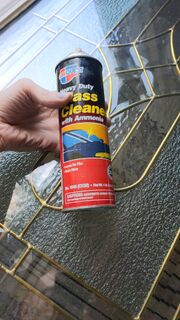Glass
Glass is unique among common solid substances. It is neither crystalline nor amorphous. Technically a super-cooled liquid, glass exists in solid form at room temperature only due to a loophole in the laws of quantum physics. The study of glass is undertaken by scientists known as 'glassholes'.
History[edit]
In 1767, the physicist Ben Dover showed that just as electrons can be thought of as "holes" in a sea of anti-electrons, un-electrons are the inverse of holes: bumps which exclude anti-electrons, but are not "holes" either.[1] Glass windows were invented as a an alternative method to killing birds. Since skyscrapers, their success rate has grown enourmously.
Unlike positrons, Eugenie Diract's "bumps" have not received a common name, although Nils Bohr once sent her a fetching red lace brassiere. It is, however, the presence of these "bumps" which allow glass to solidify without crystallizing.
Characteristics[edit]
The most profound attribute of glass is invisibility. No one can see glass, and consequently, hundreds of people walk through plate-glass doors every year. Those who do not, still marvel at the low number of mosquitoes inside their homes though no one can see what is keeping them out.
Despite its appearance of solidity, glass can and does flow. Common window glass slumps gradually over time and the windowpanes in Grandma's house may be so irregular that they bend gravity waves and present a distorted view. This is why Grandma looks so frumpy. In an elegant demonstration of the large-scale application of quantum physics, this gravitational distortion can, in extreme cases, force the observer's eyes to focus on the bridge of his own nose — the famous "Einstein cross" phenomenon seen in certain photographs taken by the Hubble Space Telescope.
In architecural applications, the use of glass should be considered carefully. For example, it is vital to use glass at a low level in child care centers, schools and the like.
Modern trends[edit]

Specialized plastics have replaced glass in many applications. LEDs use demon-proofed plastic rather than the glass; fighter pilots are protected by Plexiglas which, ironically, is not glass but a hardened plastic rolled onto their bodies before they put on their flight suits. And, of course, "glass" eyes are made of polyarsenide plastic, which prevents the growth of fungus in the eye socket. Early attempts to use actual glass in prosthetic eyes caused dense growths of shiitake and matsutake mushrooms to sprout from beneath the eyelids of the recipients, and poisonous amanitas sometimes sprouted from the tear ducts.
Volcanic glass is formed underground by the activity of microscopic black holes in the Earth's crust. It is coloured, and despite anti-segregation laws, it has been mostly excluded from employment in the windows industry.
References[edit]
- ↑ Anti-electrons are now called positrons, of course. Some truck differential gear boxes relied on the transmission of positrons in order to maintain traction — positraction.
